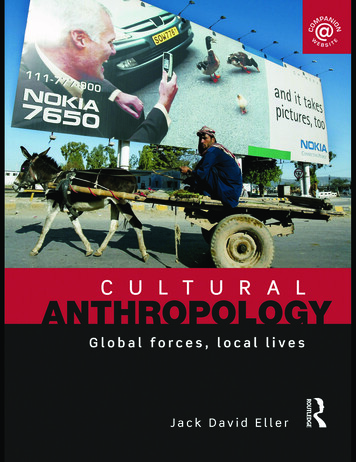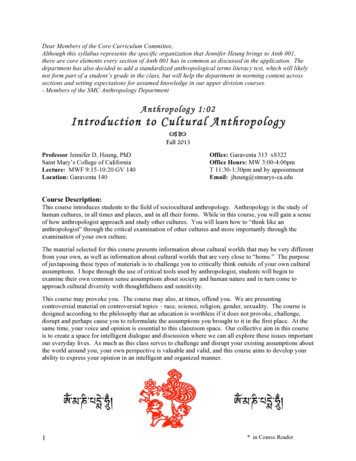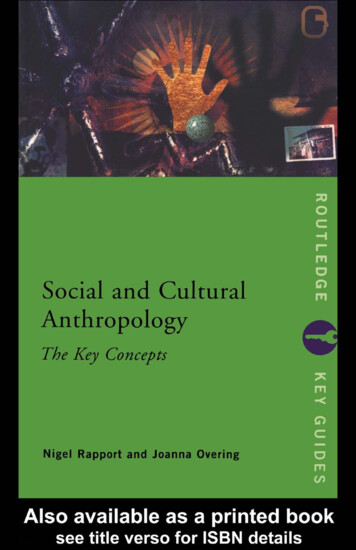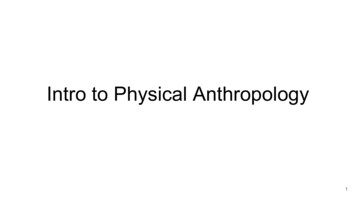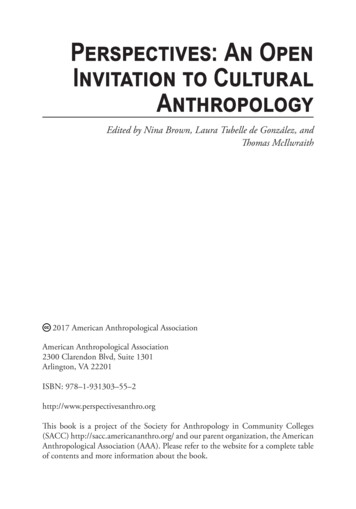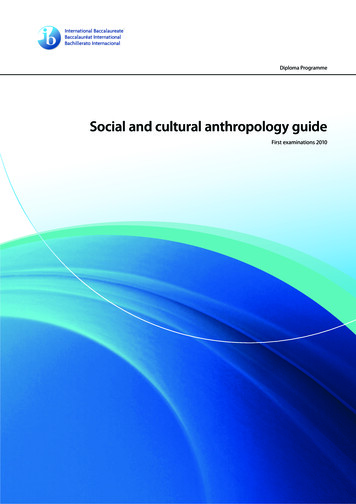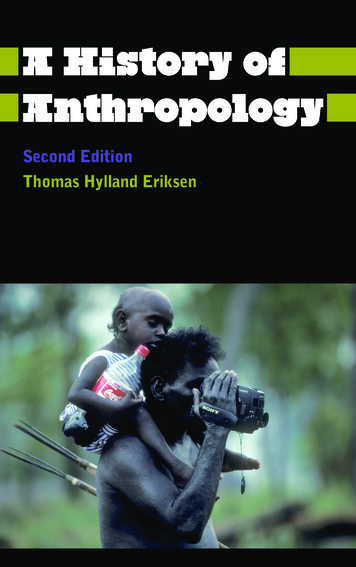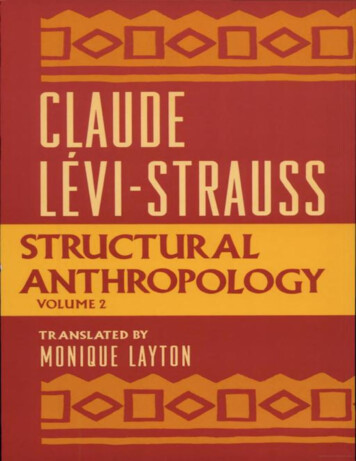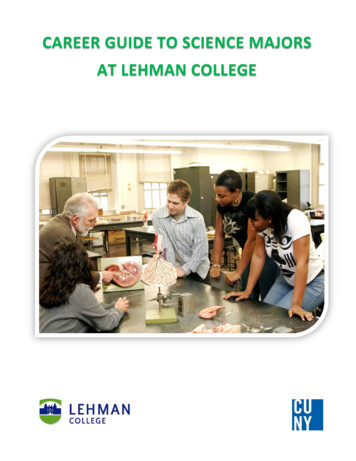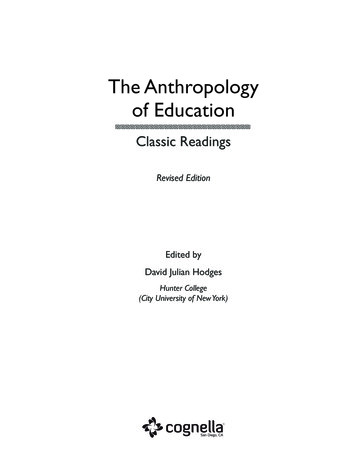
Transcription
The Anthropologyof EducationeeeeeeeeeeeeeeeeeeeeeeeeeeeeeeClassic ReadingsRevised EditionEdited byDavid Julian HodgesHunter College(City University of New York)
Copyright 2011 by David Julian Hodges. All rights reserved. No part of this publication may be reprinted, reproduced, transmitted, or utilized in any form or by anyelectronic, mechanical, or other means, now known or hereafter invented, includingphotocopying, microfilming, and recording, or in any information retrieval systemwithout the written permission of University Readers, Inc.First published in the United States of America in 2011 by Cognella, a division ofUniversity Readers, Inc.Trademark Notice: Product or corporate names may be trademarks or registered trademarks, and are used only for identification and explanation without intent to infringe.15 14 13 12 1112345Printed in the United States of AmericaISBN: 978-1-934269-77-0
ContentseeeeeeeeeeeeeeeeeeeeePrefaceBy David Julian HodgesviiCHAPTER ONE: THE CULTURE CONCEPT1IntroductionBy David Julian Hodges3Magical Practices Among the NaciremaBy Horace Miner5Why Indians?By Frederick O. Gearing11Anthropology and Education: An OverviewBy George D. Spindler19One Hundred Percent AmericanBy Ralph Linton41CHAPTER TWO: ANTHROPOLOGY OF EDUCATION45IntroductionBy David Julian Hodges47Continuities and Discontinuities in Cultural ConditioningBy Ruth Benedict51Docility, Or Giving Teacher What She WantsBy Jules Henry61The Education of the Hopi ChildBy Laura Thompson and Alice Joseph71
Enculturation and the Life Cycle Among the AmishBy John Hostetler and Gertrude Enders Huntington77Cultural Transmission of Parental AnxietyBy Margaret Mead87The Cultural Significance of the Child StarBy Jane O’Connor93CHAPTER THREE: ANTHROPOLOGY AND EDUCATION123IntroductionBy David Julian Hodges125Field Anthropologists and Classroom TeachersBy Paul J. Bohannan129Cultural Anthropology and EducationBy F. Robert Paulsen139A Contribution of Anthropology to the Education of the TeacherBy Robert Redfield149The Acculturation of the School TeacherBy George D. Spindler159The High School of the FutureBy Margaret Mead163CHAPTER FOUR: ANTHROPOLOGY IN EDUCATION173IntroductionBy David Julian Hodges175PART ONE: CLASSIC THINKERS177Confucius 551–479 BCE179Socrates 469–399 BCE185
Friedrich Wilhelm Froebel 1782–1852191Eugenio María De Hostos 1839–1903197Émile Durkheim 1858–1917205Anna Julia Haywood Cooper 1858–1964211Rabindranath Tagore 1861–1941221PART TWO: CONTEMPORARY THINKERS227Lev Semyonovich Vygotsky 1896–1934229Jean Piaget 1896–1980235M. K. Gandhi 1869–1948241Michael W. Apple 1942–247Pierre Bourdieu 1930–257Martin Buber 1878–1965263William Edward Burghardt Du Bois 1868–1963269CHAPTER FIVE: THE ANTHROPOLOGY OF PARADOX INEDUCATION277IntroductionBy David Julian Hodges279Savage InequalitiesBy Jonathan Kozol281Pedagogy of the OppressedBy Paulo Freire291DisciplineBy Maria Montessori299
A Talk to TeachersBy James Baldwin309Acknowledgments315
PrefaceeeeeeeeeeeeeeeeeeeeeeBy David Julian HodgesCLASSIC READINGS IN THE ANTHROPOLOGY OF EDUCATIONThe formal study of anthropology and education is a little over fifty yearsold. Many of those who pioneered the field are persons I knew. Dr. EthelJ. Alpenfels, my doctoral mentor at New York University is one of those.A brief mention is made of Dr. Alpenfels’ role in the development of anthropologyand education in Chapter One of this book in the article by George D. Spindler.Few students who have taken any of my anthropology courses have left the courseunaware of my keen admiration of my teacher, or unaware of the profound influenceDr. Alpenfels continues to have on my life and on my career as an anthropologist.I have compiled this collection of articles because I believe there is a great needtoday for the insights that the articles provide. The anthropologists whose articles areincluded here are masters in the field. Their names constitute a veritable who’s whoin cultural anthropology. Mead, Linton, Benedict, and Redfield, to name a few, arelegends in the field. You will see from each of their articles, and from the articles ofother authors represented in this text, that they gave specific attention to anthropology and education. The need for their thinking in this important realm of study isas great today, and arguably greater, than when their articles were first written, someas long as fifty years ago. Their incredible work and insights must not fall prey to theawful tendency of our era that scholarship should be both instant and disposable.Still, many of these articles are out-of-print and otherwise unavailable. In previousyears, I could only make a few of them available for the use of my classes in anthropology and education, despite their currency and importance, vis á vis the pressing issuesof our day.Students who are using this anthology are reading articles written by the best ofthe best anthropologists who have applied their insights to education. The articlesare indeed classics, and they are important tools for any teacher of anthropology andeducation to use in a quest to inspire and influence students, as Ethel Alpenfels inspiredand influenced me.Preface vii
This anthology is divided into five chapters, each dealing with an aspect of its generaltheme, anthropology in relation to education. Culture concept and education—exploration of the idea of culture and themeaning and dynamics of the culture concept in education. Anthropology of education—the anthropology of how culture is transmittedfrom generation to generation through child rearing and enculturation in thebroadest sense. Anthropology and education—the conjunction of the disciplines of anthropology and education. Anthropological insights related to the idea of schooling, theinstitution of the school, and the training of teachers. Anthropology in education—the influence, effects, and potential of anthropology in education. Anthropology of paradox in education—the study of culture patterns and cultural transmission when these conflict with or contradict what society purportsto hold in high esteem.The very useful framework that places emphasis on the prepositions of, and, and indistinguishing various ways anthropology can relate to education was first introducedin Cultural Relevance and Educational Issues, by Francis Ianni and Edward Storey. Thecategories used here differ somewhat from their use by Ianni and Storey, but usinga framework of this sort provides clarity and definition, and this previous work isgratefully acknowledged.David Julian Hodgesviii The Anthropology of Education
Chapter OneeeeeeeeeeeeeeeeeeeeeThe Culture ConceptREADINGS IN THIS SECTIONIntroductionBy David Julian Hodges3Magical Practices Among the NaciremaBy Horace Miner5Why Indians?By Frederick O. Gearing11Anthropology and Education: An OverviewBy George D. Spindler19One Hundred Percent AmericanBy Ralph Linton41
IntroductioneeeeeeeeeeeeeeeeeeeeeBy David Julian HodgesDoes anthropology have anything to contribute to the enterprise of teaching and learning? What contributions does the culture concept make toour understanding of human behavior and the acquisition of values? Theearliest influence of anthropology in education can be traced to the beginning yearsof the twentieth century—for example with Emile Durkheim, an anthropologist(sometimes claimed by sociology) and philosopher John Dewey who sought to aligneducation with the attitudinal and behavioral requirements of a cultural democracy.The readings in Chapter One, however, are from the middle years of that century, aperiod we could describe as a tenuous awakening or at least a period of consolidation of perspectives pertaining to the intersection of anthropology and education.These readings set the stage for exploring how culture shapes assumptions, beliefs,and ultimately behavior in all aspects of the human experience and specifically ineducation.The readings in Chapter One move quickly from a general introduction to theconcept of culture as the core concern of cultural anthropology to the central messageexpressed as a juxtaposition of the anthropological perspective regarding indigenouscultures and modern ones. The readings provide a straightforward description of therelevance of the study of culture to modern problems and an overview of how thedisciplines of anthropology and education have come together around the goals ofeducation. We like to believe that the attributes of our own culture are unique andoriginal. However the final reading in Chapter One, Ralph Linton’s “One HundredPercent American” illuminates the fundamental error of such a belief and, in addition,points to the need to apply cultural analysis to our own schools and the communitiesof which they are a part. Readers are encouraged to become aware of their beliefs aboutculture in general and their own cultures in particular, and to be prepared to challengetheir assumptions and beliefs through the readings in Chapter One as well as the readings in the remaining parts of this anthology.“Magical Practices among the Nacirema” by Horace Miner describes the practicesof the familiar-sounding people of Nacirema that seem to betray a strong underlyingbelief in magic and superstition. Miner, a professor at the University of Michigan formost of his career, was deeply interested in examining the cultural contexts in whichthe individual actions of people take place. In a surprising and humorous way, thisreading puts side by side the anthropological perspective regarding indigenous culturesand what we take to be advanced, modern cultures.Frederick Gearing begins to make the connection between anthropology andeducation by connecting the study of American Indians (Native Americans) with theIntroduction 3
concepts of anthropology and describes ways in which “educational profits” may begained by such study. (It should be noted here that Gearing is given a pass in using theterm “Indian” in his article, since his article was written in the 60s.) The focus is onteaching anthropology, under some suitable rubric in order to bring about educationalbenefits in the broadest sense. The first of these “profits” pertains to how a properstudy of an Indian community will permit a student to recognize that any culturallypatterned behavior, no matter how bizarre it may appear to outside observers, makesplausible sense, is believable, and fully human. This perspective leads one to criticallyask, “What don’t I know about what I am observing?” When we come to understandthat those who are not like us, “others” so to speak, are not crazy or evil, the risk to ourcommon good may be reduced. The second of these “profits” pertains to how the studyof Indians can help students see and comprehend their own world more clearly. To thisend, anthropology brings the critical heuristic device of comparison. In heterogeneouseducational settings, the study of alien cultures can enable students to develop a deeperunderstanding and tolerance for their own and other cultures.The essay by George Spindler is a mid-twentieth century overview of the potential,successes, gaps, and limitations associated with anthropology as a contributor to thefield of education and, to some extent, vice versa. It outlines how both anthropologyand education relate to mutual interests and influences and chronicles the state offormal and institutional collaboration between these disciplines. Spindler argues thatanthropology, as the study of man and his works, provides a loose integration of muchthat is vitally important concerning man and his behavior. The view of educationas a total process of growth and adaptation, leads to the conception of education asthe process of transmitting culture, including skills, knowledge, attitudes, values andbeliefs as well as specific behavior patterns. Anthropology as content or curricula ineducation at all levels is identified as one application of the discipline. Anthropology asa frame of reference and a methodology for analysis of educational processes is anotherapplication along with the potential to study and influence educational processes asaffected by social class and community structure.The influence of anthropology as a potential contributor to and shaper of foundation fields pertains to the context of professional education. These fields provide theframework for the development of programs where teachers, administrators, counselors, and others are trained. The general rubrics of the foundation fields are sociological, psychological, philosophical, historical, biological, and comparative. In Spindler’sperspective, the core of the potential contribution of anthropology is in the attentionto culture as an influence on behavior, as a perception mediating a set of patterns, andin the attention to the variable forms these patterns take. There are also many areas ofpotential application of anthropologically based concepts and methods in educationalresearch in our own society, to which, according to Spindler, more attention should bedirected.4 The Anthropology of Education
Magical PracticesAmong the NaciremaeeeeeeeeeeeeeeeeeeeeeBy Horace MinerThe anthropologist has become so familiar with the diversity of ways in whichdifferent peoples behave in similar situations that he is not apt to be surprised by even the most exotic customs. In fact, if all of the logically possiblecombinations of behavior have not been found somewhere in the world, he is aptto suspect that they must be present in some yet undescribed tribe In this light,the magical beliefs and practices of the Nacirema present such unusual aspects thatit seems desirable to describe them as an example of the extremes to which humanbehavior can go.Professor Linton first brought the ritual of the Nacirema to the attention ofanthropologists twenty years ago, but the culture of this people is still very poorlyunderstood. They are a North American group living in the territory between theCanadian Cree, the Yaqui and Tarahumare of Mexico, and the Carib and Arawak ofthe Antilles. Little is known of their origin, although tradition states that they camefrom the east. According to Nacirema mythology, their nation was originated by aculture hero, Notgnihsaw, who is otherwise known for two great feats of strength—thethrowing of a piece of wampum across the river Pa-To-Mac and the chopping down ofa cherry tree in which the Spirit of Truth resided.Nacirema culture is characterized by a highly developed market economy whichhas evolved in a rich natural habitat. While much of the people’s time is devoted toeconomic pursuits, a large part of the fruits of these labors and a considerable portionof the day are spent in ritual activity. The focus of this activity is the human body, theappearance and health of which loom as a dominant concern in the ethos of the people.While such a concern is certainly not unusual, its ceremonial aspects and associatedphilosophy are unique.The fundamental belief underlying the whole system appears to be that the humanbody is ugly and that its natural tendency is to debility and disease. Incarcerated insuch a body, man’s only hope is to avert these characteristics through the use of thepowerful influences of ritual and ceremony. Every household has one or more shrinesdevoted to this purpose. The more powerful individuals in the society have severalshrines in their houses and, in fact, the opulence of a house is often referred to in termsHorace Miner, “Magical Practices Among the Nacirema,” from Exploring the Ways of Mankind, pp.521–526. Copyright 1971 Cengage. Permission to reprint granted by the publisher.Magical Practices Among the Nacirema 5
of the number of such ritual centers it possesses. Most houses are of wattle and daubconstruction, but the shrine rooms of the more wealthy are walled with stone. Poorerfamilies imitate the rich by applying pottery plaques to their shrine walls.While each family has at least one such shrine, the rituals associated with it are notfamily ceremonies but are private and secret. The rites are normally only discussedwith children, and then only during the period when they are being initiated intothese mysteries. I was able, however, to establish sufficient rapport with the natives toexamine these shrines and to have the rituals described to me.The focal point of the shrine is a box or chest which is built into the wall. In thischest are kept the many charms and magical potions without which no native believeshe could live. These preparations are secured from a variety of specialized practitioners.The most powerful of these are the medicine men, whose assistance must be rewardedwith substantial gifts. However, the medicine men do not provide the curative potionsfor their clients, but decide what the ingredients should be and then write them downin an ancient and secret language. This writing is understood only by the medicinemen and by the herbalists who, for another gift, provide the required charm.The charm is not disposed of after it has served its purpose, but is placed in thecharm-box of the household shrine. As these magical materials are specific for certainills, and the real or imagined maladies of the people are many, the charm-box is usuallyfull to overflowing. The magical packets are so numerous that people forget what theirpurposes were and fear to use them again. While the natives are very vague on thispoint, we can only assume that the idea in retaining all the old magical materials is thattheir presence in the charm-box, before which the body rituals are conducted, will insome way protect the worshipper.Beneath the charm-box is a small font. Each day every member of the family, insuccession, enters the shrine room, bows his head before the charm-box, mingles different sorts of holy water in the font, and proceeds with a brief rite of ablution. Theholy waters are secured from the Water Temple of the community, where the priestsconduct elaborate ceremonies to make the liquid ritually pure.In the hierarchy of magical practitioners, and below the medicine men in prestige,are specialists whose designation is best translated “holy-mouth-men.” The Naciremahave an almost pathological horror of and fascination with the mouth, the conditionof which is believed to have a supernatural influence on all social relationships. Were itnot for the rituals of the mouth, they believe that their teeth would fall out, their gumsbleed, their jaws shrink, their friends desert them, and their lovers reject them. Theyalso believe that a strong relationship exists between oral and moral characteristics.For example, there is a ritual ablution of the mouth for children which is supposed toimprove their moral fiber.The daily body ritual performed by everyone includes a mouth-rite. Despite thefact that these people are so punctilious about care of the mouth, this rite involves apractice which strikes the uninitiated stranger as revolting. It was reported to me that6 The Anthropology of Education
the ritual consists of inserting a small bundle of hog hairs into the mouth, along withcertain magical powders, and then moving the bundle in a highly formalized series ofgestures.In addition to the private mouth-rite, the people seek out a holy-mouth-man onceor twice a year. These practitioners have an impressive set of paraphernalia, consistingof a variety of augers, awls, probes, and prods. The use of these objects in the exorcismof the evils of the mouth involves almost unbelievable ritual torture of the client.The holy-mouth-man opens the client’s mouth and, using the above mentioned tools,enlarges any holes which decay may have created in the teeth. Magical materials are putinto these holes. If there are no naturally occurring holes in the teeth, large sections ofone or more teeth are gouged out so that the supernatural substance can be applied.In the client’s view, the purpose of these ministrations is to arrest decay and to drawfriends. The extremely sacred and traditional character of the rite is evident in the factthat the natives return to the holy-mouth-men year after year, despite the fact that theirteeth continue to decay.It is to be hoped that, when a thorough study of the Nacirema is made, there willbe careful inquiry into the personality structure of these people. One has but to watchthe gleam in the eye of a holy-mouth-man, as he jabs an awl into an exposed nerve,to suspect a certain amount of sadism is involved. If this can be established, a veryinteresting pattern emerges, for most of the population shows definite masochistictendencies. It was to these that Professor Linton referred in discussing a distinctivepart of the daily body ritual which is performed only by men. This part of the riteinvolves scraping and lacerating the surface of the face with a sharp instrument. Specialwomen’s rites are performed only four times during each lunar month, but what theylack in frequency is made up in barbarity. As part of this ceremony, women bake theirheads in small ovens for about an hour. The theoretically interesting point is that whatseems to be a preponderantly masochistic people have developed sadistic specialists.The medicine men have an imposing temple, or latipso, in every community of anysize. The more elaborate ceremonies required to treat very sick patients can only beperformed at this temple. These ceremonies involve not only the thaumaturge but apermanent group of vestal maidens who move sedately about the temple chambers indistinctive costume and headdress.The latipso ceremonies are so harsh that it is phenomenal that a fair proportionof the really sick natives who enter the temple ever recover. Small children whoseindoctrination is still incomplete have been known to resist attempts to take them tothe temple because “that is where you go to die.” Despite this fact, sick adults are notonly willing but eager to undergo the protracted ritual purification, if they can affordto do so. No matter how ill the supplicant or how grave the emergency, the guardiansof many temples will not admit a client if he cannot give a rich gift to the custodian.Even after one has gained admission and survived the ceremonies, the guardians willnot permit the neophyte to leave until he makes still another gift.Magical Practices Among the Nacirema 7
The supplicant entering the temple is first stripped of all his or her clothes. In everyday life the Nacirema avoids exposure of his body and its natural functions. Bathingand excretory acts are performed only in the secrecy of the household shrine, wherethey are ritualized as part of the body-rites. Psychological shock results from the factthat body secrecy is suddenly lost upon entry into the latipso. A man, whose own wifehas never seen him in an excretory act, suddenly finds himself naked and assisted by avestal maiden while he performs his natural functions into a sacred vessel. This sort ofceremonial treatment is necessitated by the fact that the excreta are used by a divinerto ascertain the course and nature of the client’s sickness. Female clients, on the otherhand, find their naked bodies are subjected to the scrutiny, manipulation and proddingof the medicine men.Few supplicants in the temple are well enough to do anything but lie on their hardbeds. The daily ceremonies, like the rites of the holy-mouth-men, involve discomfortand torture. With ritual precision, the vestals awaken their miserable charges eachdawn and roll them about on their beds of pain while performing ablutions, in theformal movements of which the maidens are highly trained. At other times they insertmagic wands in the supplicant’s mouth or force him to eat substances which are supposed to be healing. From time to time the medicine men come to their clients and jabmagically treated needles into their flesh. The fact that these temple ceremonies maynot cure, and may even kill the neophyte, in no way decreases the people’s faith in themedicine men.There remains one other kind of practitioner, known as a “listener.” This witchdoctor has the power to exorcise the devils that lodge in the heads of people whohave been bewitched. The Nacirema believe that parents bewitch their own children.Mothers are particularly suspected of putting a curse on children while teaching themthe secret body rituals. The counter-magic of the witch-doctor is unusual in its lackof ritual. The patient simply tells the “listener” all his troubles and fears, beginningwith the earliest difficulties he can remember. The memory displayed by the Naciremain these exorcism sessions is truly remarkable. It is not uncommon for the patient tobemoan the rejection he felt upon being weaned as a babe, and a few individuals evensee their troubles going back to the traumatic effects of their own birth.In conclusion, mention must be made of certain practices which have their basein native esthetics but which depend upon the pervasive aversion to the natural bodyand its functions. There are ritual fasts to make fat people thin and ceremonial feaststo make thin people fat. Still other rites are used to make women’s breasts larger ifthey are small, and smaller if they are large. General dissatisfaction with breast shapeis symbolized in the fact that the ideal form is virtually outside the range of humanvariation. A few women afflicted with almost inhuman hypermammary developmentare so idolized that they make a handsome living by simply going from village to villageand permitting the natives to stare at them for a fee.8 The Anthropology of Education
Reference has already been made to the fact that excretory functions are ritualized, routinized, and relegated to secrecy. Natural reproductive functions are similarlydistorted. Intercourse is taboo as a topic and scheduled as an act. Efforts are made toavoid pregnancy by the use of magical materials or by limiting intercourse to certainphases of the moon. Conception is actually very infrequent. When pregnant, womendress so as to hide their condition. Parturition takes place in secret, without friends orrelatives to assist, and the majority of women do not nurse their infants.Our review of the ritual life of the Nacirema has certainly shown them to be amagic-ridden people. It is hard to understand how they have managed to exist so longunder the burdens which they have imposed upon themselves. But even such exoticcustoms as these take on real meaning when they are viewed with the insight providedby Malinowski when he wrote:Looking from far and above, from our high places of safety in the developed civilization, it is easy to see all the crudity and irrelevance of magic. But without its power andguidance early man could not have mastered his practical difficulties as he has done,nor could man have advanced to the higher stages of civilization.Magical Practices Among the Nacirema 9
Why Indians?eeeeeeeeeeeeeeeeeeeeeBy Frederick O. GearingIlike American Indians, it happens, and that creates a certain handicap in pursuitof the current purpose. Liking something is a nice but rather trivial reason for suggesting that students study it, at least during the already crowded school day. Thepurpose here is to suggest that nontrivial, fully serious educational profit can be realizedin the schools through the study of Indian communities, past and present. The case couldperhaps be made more compellingly by an anthropologist who knows Indian life andfinds that life personally unattractive. (Of which anthropologists there are, contrary topublic myth, many; furthermore, to be such an anthropologist is quite respectable.)Why Indians? I shall put the question in this form: What serious educational profitswould accrue to a student who, after study, does not find Indian life especially attractive or fascinating or even interesting in and of itself?North American Indians form, of course, a highly varied array of communities.Southwestern groups are best known to most and include farmers settled in tightlyknit villages, as the Zuni, and include other groups, nomadic and seminomadic, whoonce lived by hunting and gathering and by raiding. Along the northwest coast, fromsouthern Alaska to northern California, is another array of Indian communities which,as the Kwakiutl, were blessed by bountiful nature (in the form of salmon, mainly) to thedegree that they spent a good deal of their time gathering quite useless surplus wealthand giving it away in a stylized, often arrogant way. Southward from that area and intothe desert interior lived the economic opposites of the northwestern groups, the verypoor, as the Paiutes, whose lives often were an unceasing struggle for survival, so much sothat their various cultures seemed to include virtually any practice that would help keepbody and soul together. Through the entire eastern half of the continent, from Floridainto the far northern interior of Canada, lived a very large array of groups—those of theGreat Lakes were gardeners and hunters, and those north of there solely hunters. TheEskimos covered the entire northern fringe of the continent. Finally, after the coming ofEuropeans and the horse, there occurred a cultural explosion of sorts which resulted inthe creation, overnight as it were, of the horse-and-buffalo cultures of the High Plains,as among the famous Dakotas (Sioux) and Cheyenne. All these peoples spoke over 150mutually unintelligible languages which fall into five large language families. Amongthese peoples are found all the basic forms of human kinship organizations, a welter offorms of political organization, a wide variety of religious belief and ritual.Frederick O. Gearing, “Why Indians?” from Social Education 32(2), pp. 128–131. Copyright 1968National Council for the Social Studies. Permission to reprint granted by the publisher.Why Indians? 11
It of course follows: one does not in the schools “study Indians,” but one may studysome selected group of Indians. For serious educational purposes, it does not matterwhich, provided only that decent
Cultural Anthropology and Education 139 By F. Robert Paulsen A Contribution of Anthropology to the Education of the Teacher 149 By Robert Redfi eld Th e Acculturation of the School Teacher 159 By George D. Spindler Th e High School of the Future 163 By Margaret Mead CHAPTER FOUR: ANTHROPOLOGY
